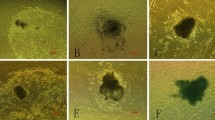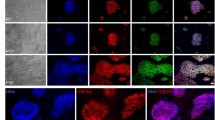Abstract
Although isolation and characterization of embryonic stem cells have been successful in cattle, maintenance of bovine embryonic stem cells in culture remains difficult. In this study, we compared different methods of cell passaging, feeder cell layers and medium conditions for bovine embryonic stem cell-like cells. We found that a murine embryonic fibroblast feeder layer is more suitable for embryonic stem cell-like cells than bovine embryonic fibroblasts. When murine embryonic fibroblasts were used, a mechanical method of passaging led to better cell growth than passaging by trypsin digestion. We also found that exogenous supplementation with leukemia inhibitory factor maintained the embryonic stem cell-like cells in an undifferentiated state, whereas addition of stem cell factor resulted in their differentiation. Our findings provide an experimental basis for the establishment of an effective culture system for bovine embryonic stem cells.







Similar content being viewed by others
References
Behboodi E, Bondareva A, Begin I, Rao K, Neveu N (2011) Establishment of goat embryonic stem cells from in vivo produced blastocyst-stage embryos. Mol Reprod Dev 78:202–211
Bettiol E, Sartiani L, Chicha L, Krause KH, Cerbai E, Jaconi ME (2007) Fetal bovine serum enables cardiac differentiation of human embryonic stem cells. Int Soc Differ 75:669–681
Boiani M, Scholer HR (2005) Regulatory networks in embryo derived pluripotent stem cells. Nat Rev Mol Cell Biol 6:872–884
Brook FA, Gardner RL (1997) The origin and efficient derivation of embryonic stem cells in the mouse. Proc Natl Acad Sci USA 94:5709–5712
Bryja V, Bonilla S, Arenas E (2006) Derivation of mouse embryonic stem cells [J]. Nat Protoc 1:2082–2087
Cao S, Wang F, Chen Z, Liu Z, Mei C, Wu H, Huang J, Li C, Zhou L, Liu L (2009) Isolation and culture of primary bovine embryonic stem cell colonies by a novel method. J Exp Zool 311:368–376
Chambers I, Colby D, Robertson M, Nichols J, Lee S, Tweedie S, Smith A (2003) Functional expression cloning of nanog a pluripotency sustaining factor in embryonic stem cells. Cell 113:643–655
Darr H, Mayshar Y, Benvenisty N (2006) Overexpression of NANOG in human ES cells enables feeder-free growth while inducing primitive ectoderm features. Development 133:1193–1201
Eckary DC, Lawrence SB, Juengel JL, Greenwood P, McNatty KP, Fidler AE (2002) Gene expression of the tyrosine kinase receptor c-kit during ovarial development in the brush tail possum. Biol Reprod 66:346–353
Evans MJ, Kaufman MH (1981) Establishment in culture of pluripotential cells from mouse embryos. Nature 292:154–156
Familari M, Selwood L (2006a) The potential for derivation of embryonic stem cells in vertebrates. Mol Reprod Dev 73:123–131
Familari M, Selwood L (2006b) The potential for derivation of embryonic stem cells in vertebrates. Mol Reprod Dev 73:123–131
Gjørret JO, Maddox-Hyttel P (2005) Attempts towards derivation and establishment of bovine embryonic stem cell-like cultures. Reprod Fertil Dev 17:113–124
Hamano S, Watanabe Y, Azuma S (1998) Establishment of embryonic stem (ES) cell-like cell lines derived from bovine blastocysts obtained by in vitro culture of oocytes matured and fertilized in vitro. J Reprod Dev 44:297–303
Huang B, Li T, Wang XL, Xie TS, Lu YQ, da Silva FM, Shi DS (2010) Generation and characterization of embryonic stem-like cell lines derived from in vitro fertilization buffalo (Bubalus bubalis). Embryos 45:122–128
Li M, Li YH, Hou Y, Sun XF, Sun Q, Wang WH (2004) Isolation and culture of pluripotent cells from in vitro produced porcine embryos. Camb Univ Press 12:43–48
Manova K, Nocka K, Besmer P, Bachvarova RF (1990) Gonadal expression of c-kit encoded at the W locus of the mouse. Development 110:1057–1069
Miyoshi K, Taquchi Y, Sendai Y, Hoshi H, Sato E (2000) Establishment of a porcine cell line from in vitro-produced blastocysts and transfer of the cells into enucleated oocytes. Biol Reprod 62:1640–1646
Munoz M, Rodriguez A, De Frutos C, Caamano JN, Diez C, Facal N, Gomez E (2008) Conventional pluripotency markers are unspecific for bovine embryonic-derived cell-lines. Theriogenology 69:1159–1164
Pawar SS, Malakar D, De AK, Akshey YS (2009) Stem cell-like outgrowths from in vitro fertilized goat blastocysts. Indian J Exp Biol 47:635–642
Reubinoff BE, Pera MF, Fong CY, Trounson A, Bonso A (2000) Embryonic stem cell lines from human blastocysts: somatic differentiation in vitro. Nat Biotechnol 18:399–404
Roach M, Wang L, Xiang zhong Yang X, Tian C (2006) Bovine embryonic stem cells. Methods Enzymol 418:21–37
Smith AG, Hooper ML (1987) Buffalo rat liver cells produce a diffusible activity which inhibits the differentiation of murine embryonal carcinoma and embryonic stem cells. Dev Biol 121:1–9
Strojek RM, Reed MA, Hoover JL, Waqner TE (1990) A method for cultivation morphological undifferentiated embryonic stem cells from porcine blastocysts. Theriogenology 33:901–913
Sulston JE, Schierenberg E, White JG, Thomson JN (1983) The embryonic cell lineage of the nematode caenorhabditis elegans. Dev Biol 100:64–119
Tada M, Takahama Y, Abe K, Nakatsuji N, Tada T (2001) Nuclear reprogramming of somatic cells by in vitro hybridization with ES cells. Curr Biol 11:1553–1558
Tervit HR, Wittingham DG, Rowson LE (1972) Successful culture in vitro of sheep and cattle ova. J Reprod Fertil 30:493–497
Thomson JA, Itskovitz-Eldor J, Shapiro SS, Waknitz MA, Swierqiel JJ, Marshall VS, Jones JM (1998) Embryonic stem cell lines derived from human blastocysts. Science 282:1145–1147
Wang L, Duan E, Sung LY, Jeong BS, Yang X, Tian XC (2005) Generation and characterization of pluripotent stem cells from cloned bovine embryos. Biol Reprod 73:149–155
Wilmut I, Schnieke AE, McWhir J, Kind AJ, Campbell KH (1997) Viable offspring derived from fetal and adult mammalian cells. Nature 385:810–813
Xu C, Inokuma MS, Denham J (2001) Feeder-free growth of undifferentiated human embryonic stem cells. Nature 19:971–974
Yan W, Suominen J, Toppari J (2000) Stem cell factor protects germ cells from apoptosis in vitro. J Cell Sci 113:161–168
Acknowledgments
This work was supported by grants from the National High Technology Research and Development Program of China (“863” Program) (2008AA101005). We gratefully thank Dr. Cang Ming (Inner Mongolia University) and Dr. Guo Xudong (Inner Mongolia University) for providing the directions.
Author information
Authors and Affiliations
Corresponding author
Rights and permissions
About this article
Cite this article
Jin, M., Wu, A., Dorzhin, S. et al. Culture conditions for bovine embryonic stem cell-like cells isolated from blastocysts after external fertilization. Cytotechnology 64, 379–389 (2012). https://doi.org/10.1007/s10616-011-9408-z
Received:
Accepted:
Published:
Issue Date:
DOI: https://doi.org/10.1007/s10616-011-9408-z




